I’ll make a reservation right away. This article is not intended for those who deal with such issues professionally. In this case, don't waste your time! The information in this article is intended for the average consumer, who sooner or later has to decide the issue of supplying and distributing electricity at home, in the country, etc. Of course, you can turn to specialists who will qualifiedly help in this matter. But if this is connected with something significant for you material costs, use the information in this article and you will see that everything is not so complicated. “It’s not the gods who burn the pots!!!”
In order for the choice of cable or wire to be correct, several conditions must be met.
1. It is necessary to determine the number of insulated wires in the cable that you are required to use.
For a connected load powered by a single-phase network (220V), these are either two wires (neutral N and phase L) or three (neutral, phase, and protective grounding wire).
For a load powered by a three-phase network (380V), these are either four wires (three phases A, B, C, and zero N) or five (three phases, neutral, and a protective ground wire).
The need for a protective grounding wire is determined by the design and type of connected load. All devices with an external metal casing must be grounded to prevent electric shock. When using sockets with a grounding contact, a cable with a protective grounding wire is required. If you use differential circuit breakers (RCDs - residual current devices) when connecting the load, then a protective grounding wire is simply necessary for their correct operation.
2. The cross-section of the current-carrying conductors (abbreviated TPZh - in the future I will use this abbreviation) must correspond to the power of the connected load.
If the cross-section is smaller, the wires will overheat (the smaller the cross-section of the TPG, the greater the resistance of the wire to the flowing electric current– therefore, at high currents, heat will be generated on the wire, like on a heating element). In addition to the fact that overheating of the wire can lead to the destruction of the protective insulating covers, short circuit and fire, a heating wire means energy loss during the transmission process!!! And it will be you who will pay for these losses!!!
If the TPG cross-section is chosen to be excessively large, then, firstly, you will spend extra money on purchasing a cable, and secondly, difficulties may arise during connection: all devices (terminal blocks of electrical installations, instruments and mechanisms, sockets, etc.) are designed for a certain power and, accordingly, a certain cross-section of connected wires. Not every “hole” can be “stuffed” into a thick wire!
To correctly select the required cross-section of the TPG, you need to know the power of the connected load. Using the table of the maximum permissible load characteristics of the wires, we find the required cross-sectional value. Maximum permissible load value for the selected section d.b. greater than the power of the connected load.
When connecting several loads to one cable, for calculations it is necessary to sum up their powers.
Having dealt with these two points, we figured out the digital part of the cable brand.
Each brand contains a letter part (characterizes the type and design of the cable) and a digital part (characterizes the number of insulated TPGs and their cross-section). For example: VVGp 3*2.5. This means a VVG type cable in a flat design (letter “p”), containing three cores with a cross-section of 2.5 mm square.
Now let's look at the "letters".
TPG wires and cables are made from copper or aluminum. A single insulated wire going on sale will be marked PV - for an insulated copper conductor, APV - for an insulated aluminum conductor.
TPZh can be structurally single-wire (mono-core) or multi-wire - made of wires of smaller cross-section, twisted together. Multi-wire TPGs provide increased flexibility of wires and cables, which may be necessary when connecting various portable (mobile) devices and electrical appliances.
The flexibility class of the wire is indicated by a number, and the larger the number, the higher the flexibility class of the wire (and the more expensive the wire).
PV1-2.5 - insulated copper wire with a single-wire conductor cross-section of 2.5 mm?
PV3-1.5 - insulated copper wire of a high flexibility class with a stranded conductor cross-section of 1.5 mm?
Let me note right away: we will talk about a limited number of cable brands (VVG, AVVG, VVG-NG, VVG NG-LS, KG, NYM, PVS, ShVVP, SIP). Despite this small limited quantity, I am sure that in 99% of cases in our “everyday” situations this will be enough.
Cables VVG and AVVG.
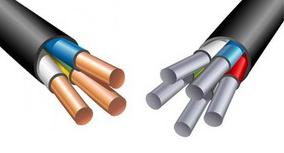
Cables of these brands are intended for installation in dry and damp rooms, for external and hidden stationary (TPZh wires - monocore, number of cores from two to five) wiring. Structurally, they are manufactured in flat (row laying of cores under the shell - VVGp, AVVGp) and twisted (round - VVG, AVVG) versions. VVG – TPZh copper, AVVG – TPZh aluminum.
The insulation of the cable wires and the outer sheath are made of cable polyvinyl chloride (PVC) plastic compounds. PVC determines the temperature range environment for operating cables from -40 °C to +50 °C, and installation and installation without preheating is possible at a temperature not lower than -15 °C. Otherwise, cracking of the protective covers and further resulting troubles is possible.
The minimum bending radius of the cable is 7.5 times its outer diameter.
The cable service life is 30 years.
Cable laying outdoors is allowed. However, in this case, the protective covers of the cable will be exposed to the ultraviolet spectrum of sunlight, and the service life of the cable will be significantly reduced - the sheath, and then the insulation, will “crack”. The most UV-resistant cable is black, since ultraviolet rays will be immediately absorbed by the surface and will not be able to penetrate into the sheath, causing destruction of the PVC polymer chains. That is why all cables for outdoor installation are produced in black color, and all regulatory documents strictly monitor this requirement!!!
When connecting the ends of the cables, please note: direct connection of copper conductors with aluminum conductors is unacceptable!!! The connection must be made either by bolting through a separating steel washer, or by using special connecting blocks in which the copper and aluminum wires are clamped separately, each with its own fastening element. Otherwise, copper and aluminum form a galvanic couple and, as a result, are intensely oxidized at the point of contact. The resistance of the connection increases, heating occurs, the insulation of the wires may melt, causing a short circuit and troubles are guaranteed!!!
The production of VVG and AVVG cables has long been mastered by industry. The cables have become very widespread, and it should be noted that the cost of these brands of cables is lower than that of others with a similar design.
Cables VVG NG, VVG NG-LS.
VVG NG is VVG cable, in which PVC plastic, which does not support combustion, is used as a protective cover. And note – precisely unsupportive! When in the area of open fire, the plastic burns, but when the flame stops exposure, it goes out. Thus, the possibility of fire spreading during electrical wiring short circuits is prevented (if, during the short circuit, other objects did not have time to catch fire before the protective voltage shutdown systems were activated).
In addition, VVG NG-LS contains additives in the insulating covers that prevent the active release of suffocating smoke (including the resulting chlorine - after all, the material is polyvinyl chloride) during thermal decomposition. This is relevant in the event of a fire: people die when they cannot leave the fire zone from suffocation!!!
For this reason, for public use and possible large crowds of people, it is necessary to use cables and wires made by NG-LS (which is what modern construction projects require).
Plastic with the described properties is more expensive and this, of course, is reflected in the cost of the cable.
KG cables.
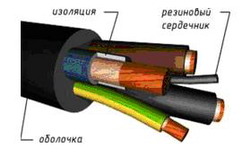
The abbreviation KG stands for flexible cable. TPZh cable – copper stranded conductors. The number of cores is from two to five. The insulation and sheath of the cores are made of rubber based on isoprene and butadiene rubbers.
The cable is intended for connecting mobile and portable devices to electrical networks. The outer sheath of the cable has increased oil and gasoline resistance and is also lightfast. The cable is resistant to repeated bending and retains these properties at low temperatures. Allows operation at an ambient temperature of -40 °C? +50°С.
The service life of KG type cables is 4 years.
NYM cables.
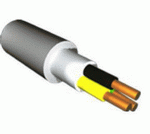
This type of cable, unlike those discussed earlier, has an additional internal filler that fills the space between the insulated cores under the sheath. The filler is made of chalk-filled vulcanized rubber, which additionally protects the insulated conductors from possible mechanical damage, and, by chipping during cutting, greatly facilitates the work when connecting the ends of the conductors. The cable is available only in a twisted (round) version and has an almost round shape.
TPZh – copper monocore. Number of cores from two to five
The insulating and outer covers of the cable are made of cable PVC with increased chalk filling. This makes the cable more rigid and the surface of the cable more “slippery”. It was these goals that were pursued when developing the design of this cable (the NYM design came to us from Europe) for use in modern construction technologies. In addition, the increased chalk filling of the cable covers ensures its reduced flammability compared to VVG. However, if NG and NG-LS properties are required, then it is in these versions that NYM must be purchased. But for this “pleasure”, of course, you will have to pay extra.
The cable service life is 30 years.
Laying outdoors without additional protection from ultraviolet radiation is unacceptable.
Ambient temperature range -30°C? +50°C, and at subzero temperatures the cable is more prone to cracking of the protective covers when bent than VVG.
This cable is significantly more expensive compared to analogues of other brands and types of cables due to the more complex technology of its manufacture and the use of additional materials. However, it is very convenient when performing a large volume of installation work. The cable is convenient for installers!!! The cable is easy to lay in pipes, closed and curved cable ducts, the cable is easy to cut and connect.
It should be taken into account that due to the internal filler, the cable will take up more volume in the cable channel.
All NYM manufacturers and suppliers declare: NYM meets the highest European standards! The thing is that every manufacturer, when producing a cable, is obliged to produce it in accordance with the developed standard for this type of product. Cable and wire products are subject to mandatory certification. This means that all cables leaving production must be accompanied by a “Certificate of Conformity” and a “Fire Safety Certificate”. Each supplier of cable and wire products is obliged, upon the buyer's request, to present and, if necessary, issue these two certificates!!!
Now about the “height” of the European standard. The NYM design is such that it takes into account not only the requirements for safe and reliable power transmission, but also modern technologies construction, when cable routes (pipes and closed curved cable channels) are bricked up during the construction of walls and ceilings. In this case, the cable is pulled into the routes by a special conductor after completion of construction and installation work. In this case, we can talk about the “height” of the NYM standard.
In all other cases, the requirements of the European and Russian standards are identical.
When doing wiring at my dacha, I refused to use NYM - why should I pay extra money?! Connecting the ends of the wires is done once and with this amount of work, the time savings when using NYM are negligible. I used regular VVG - the insulating properties of its covers are higher compared to chalk-filled NYM plastics. I also didn’t take the NG and NG-LS versions because I think that the wiring should be done competently and correctly, and not be used in extreme conditions, “as close as possible to combat” and fire conditions. The wiring must be installed in such a way that fire conditions are excluded!!! I took the VVG in a flat design, since it takes up less volume and the cable channel with a cover can be taken in a smaller size - it looks “prettier”.
PVS and ShVVP cables.
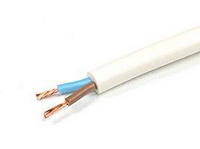
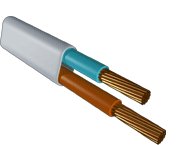
PVS ShVVP
These cables are produced only with stranded copper TPG with a cross-section of up to 2.5 mm?.
This is the reason for the widespread and even enshrined in regulatory documents name of these cables - PVS is called a wire, and SHVVP is called a cord.
PVA can contain from 2 to 5 insulated cores, and SHVVP, as a rule, contains two cores (but there can be three).
They are designed for connecting various household electrical appliances used in residential and administrative premises (refrigerators, washing machines, lamps, table lamps, etc.), as well as for connecting a variety of hand-held power tools (drills, soldering irons, garden tools, etc. .).
The insulating covers are made of PVC cable plastic compounds, which limits the ambient temperature range for their operation from -25°C to +50°C. Despite these temperature values, which are boldly indicated by all manufacturers, it should be taken into account that at low temperatures the plastic of the protective covers “dumbs”. Why can’t VVG be bent and laid without preheating at -15°C, but an extension cord made of PVA or SHVVP can be used - after all, I will have to unwind and reel it in!!! Sorry, but I don't understand this!!!
To make the correct choice between these two types, keep in mind that the ball screw is flat and, with a length of more than 1.5 m, is prone to twisting and tangling with frequent unwinding and rewinding. PVA is round, tangles less, but is heavier and occupies more volume for the same length as a ball-and-screw.
Therefore, if I need to connect a soldering iron, then I will choose a SHVVP (the soldering iron must be held suspended in your hand and precise work is required), and if we are talking about an electric drill, then I will put a PVA about five meters long (there will be no need for an extension cord and there will be less tangling ). Although, to be honest, I connect all my hand-held power tools with a KG cable - the wire remains flexible even in the cold and is more elastic due to the rubber protective covers.
SIP cables.
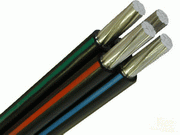
The abbreviation SIP stands for self-supporting insulated wire.
It is designed to transmit electricity in overhead lines and branches to houses and outbuildings. The insulated cable cores are simply twisted and there is no overall sheath. This is done for ease of installation and connection. When connecting to a single-phase network, they usually use a wire twisted from two insulated current-carrying wires, and when connecting to a three-phase network, from four. The most common is SIP with a TPG cross section of 16 mm?. This is what should be used for branches to your houses and outbuildings.
TPG is an aluminum stranded conductor, usually wound around a steel support wire. This allows you to use fewer supports and hangers during installation and eliminate the need for additional guy wires for hanging the cable.
The core insulation is cross-linked light-stabilized polyethylene, resistant to the damaging effects of ultraviolet radiation. This is achieved through the introduction of special additives into the insulating material and a special effect on the plastic during the manufacture of the cable. As a result, the polymer chains of the material are cross-linked and additional cross-links are formed. All this, combined with the black color of the insulation, provides very high light resistance. In addition, snow and ice do not form on the wires in winter!!!
Minimum cable laying temperature without heating -20°C
Acceptable temperature regime operation from -50 °C to +50 °C.
The cable service life is at least 30 years!!!
For cable installation, as well as for connection to previously laid overhead power supply lines, special clamps and brackets have been developed. If you use them, you won’t even have to cut the cable!!! Simply insert the cable into the special grooves and tighten the bolts on the clamps. At the same time, the mounting clamps securely fix the cable, and the connecting clamps also pierce the insulation, ensuring reliable electrical contact with the TPG.
Of course, the cost of the cable corresponds to its properties, as does the cost of special clamps and brackets. But if you need to solve problems corresponding to the design of the SIP wire, the costs will not be in vain when choosing this particular wire.
And in conclusion I would like to add. When choosing cables and protective devices for power supply, do it as correctly as possible, try to obtain the most reliable information on the issues that interest you. All reasonable expenses for your budget will result in savings!!! It would be a waste to purchase the wrong product (and it doesn’t matter whether it’s expensive or cheap)!!!
Previously, only 2 types of information were transmitted over wires: a signal for televisions ( antenna cables) and telephone conversations (telephone cables and wires). Now there is an order of magnitude more information transmitted via metal wires than even 10 years ago, which has led to the emergence of a wide variety of cables for transmitting information.
Antenna cables
In the image: cable RK 75 for a television antenna, the numbers indicate 1 - copper core, 2 - insulation, 3 - foil screen, 4 - copper braid, 5 - PVC sheath.
Nowadays the most commonly used cables for a television antenna are: RG-6, RG-59, RG-58 or Russian version RK 75. These are coaxial cables that transmit high-frequency signals well for TV and radio. Such a cable consists of a central copper core with a cross-section of 1 mm 2, surrounding polyethylene foam insulation, an aluminum foil screen, an outer copper braided conductor and a PVC protective sheath.
RG brand cables have many varieties that differ in some technical characteristics.
Computer cables (twisted pair)
In the image: cable for building computer networks with twisted pairs.

A cable consists of one or more pairs of wires, intertwined in pairs, thereby improving signal transmission. Each conductor is enclosed in PVC insulation. The cable can be enclosed in a moisture-proof sheath. The twisted pair design contains a breaking thread, which makes it easier to get to the metal cores. There are several types of cables for computer networks:
UTF unprotected, without a common shield for pairs of wires;
FTP with aluminum foil screen;
STP with a common screen made of copper mesh and each twisted pair is protected by its own screen;
S/FTP with a common foil screen and each pair is enclosed in a screen.
Cables for computer networks may have a different number of twisted pairs. The most common cable for these purposes is CAT5e, which consists of 4 pairs of wires different color.
Telephone cables and wires
There are 2 main types of telephone cables:
1. used for laying lines to the building;
2. used to connect subscribers inside the building.
TPPep the most commonly used cable for connecting a large number of subscribers. The cable consists of wires twisted in pairs. Cores made of soft copper wire with a cross-section of 0.4 or 0.5 mm 2 are covered with polyethylene insulation. The outer shell is made of the same material or vinyl.
If necessary, cable types armored with tapes or in which the internal space is filled with a hydrophobic seal are used. TPP cable can be laid in almost any conditions, underground, in cable ducts or over the air.
In the image: two-wire telephone wire TRV.
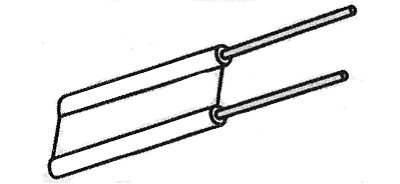
TRV single or double pair telephone wire for indoor installation. This is a flat wire with separated copper single-wire conductors with a cross section of 0.4 and 0.5 mm 2. PVC insulation. The wire can be used at temperatures from -10 to +40 °C, humidity should not exceed 80% at a temperature of 30 °C.
TRP its characteristics are similar to the expansion valve, but it is made with polyethylene insulation, which makes it better resistant to environmental influences and can be installed outside buildings.
SHTLP cord for telephone wires of increased flexibility with stranded cores. The insulation of the cores is made of polyethylene, which is covered with a PVC sheath on top. The number of cores is 2 or 4, cross-section from 0.08 to 0.12 mm 2. It is used for laying lines indoors and in telephone sets.
PRPPM flat wire with copper single-wire conductors with insulation and polyethylene sheath. There is a wire with a PVC sheath. Number of cores 2, cross-section 0.9 or 1.2 mm 2. It is used for laying telephone lines outdoors, on aerial supports, in the ground and along the walls of buildings. Temperature range for operation -60 to +60 °C.
Special types of electrical cables and wires
If you plan to operate electrical networks in conditions very different from normal, you must use special cables and wires.
RKGM power installation single-core flexible wire of increased heat resistance. Copper core, stranded, with a cross section of 0.75 - 120 mm 2. Insulation made of silicone rubber, fiberglass shell impregnated with heat-resistant enamel or varnish.
The RKGM wire is designed for a rated voltage of up to 660 V and a frequency of up to 400 Hz. Resistant to vibration, high humidity (up to 100% at a temperature of +35°C), heat-resistant (operating temperature range -60 to +180°C). The wire is protected from the harmful effects of varnishes, solvents and fungal mold. Ideal conductor for rooms with elevated temperature(boiler rooms), suitable for electrical installation in baths, saunas, connecting ovens.
PNSV single-core heating wire, single-wire core made of blued or galvanized steel. Core cross-section - 1.2; 1.4; 2 and 3 mm 2. PVC or polyethylene insulation. Rated voltage up to 380 V, frequency - 50 Hz. The wire can be used in a temperature range of -50 to +80°C, is not afraid of alkalis, and can be immersed in water. It is used as a heating element; in everyday life, warm floors are made from PNSV.runway single core copper wire. The core is multi-wire, enclosed in polyethylene insulation, the sheath is also made of polyethylene or PVC. Core cross-section 1.2 - 25 mm 2 . Rated voltage 380 or 660 V, frequency 50 Hz. The wire is resistant to pressure changes. Operating temperature range -40 to +80°C. Most often used for motors of artesian wells immersed in water under high pressure conditions.
LED cable it consists of a conductive core along which additional wires are placed with LEDs of different colors connected in series. The diodes are usually located at a distance of 2 cm. This cable can be used to create luminous solutions for home or stage interiors.
There are also electroluminescent wires that are similar to LED cables. Using such wires you can create luminous inscriptions; this is a more convenient alternative to neon tubes, since the cable is cheaper and unlimited in length.
Additional articles with useful information
Without refrigerator, TV and washing machine life is difficult for most modern people, but many people don’t think about the operating rules, thanks to which you can save money and increase the service life of household appliances.
Many private builders do the electrical wiring in houses and apartments themselves. Choosing a wire is a dilemma that arises almost immediately to make right choice It is necessary to study the basic properties of electrical wires used in everyday life.
Cable products or cable and wire products usually refer to any type of bare or insulated conductors, primarily intended for the transmission of electrical energy or information, as in computer networks.
Conductor and cable products include insulated and non-insulated cords, tapes, wires, optical cables with cores made of light-conducting fibers, busbars, cables with metal conductive cores.
Cord- these are several insulated flexible or especially flexible conductors with a cross-section of up to 1.5 mm, laid parallel or maybe twisted, on top of which, again, depending on the operating conditions, a non-metallic sheath and protective cover can be applied
The wire- these are insulated conductors or even one non-insulated one, on top of which, depending on the installation and operating conditions, there may be a non-metallic sheath, winding or braiding with fibrous materials or wire.
Cable- one or more insulated conductors (conductors), enclosed in a non-metallic or metal sheath, on top of which, depending on the laying and operating conditions, a protective cover may be applied, which may include armor.
Based on the type of insulation of power cables, there are:
- power cables with plastic insulation;
- power cables with paper insulation, including oil-filled and impregnated ones;
- power cables with rubber insulation etc.
Prednpurpose of cables and their classification
Cables, depending on the material of the transmitted energy, conductive cores or information, are divided into two groups:
- Cables with optical fibers.
- Electrical cables with metal conductors.
Cables with optical cores most often have additional metal conductors. Electrical cables with metal conductors are classified by type of insulation, voltage, purpose and many other characteristics.
Based on the linear operating voltage, power cables are divided into:
- cables for voltage 1..10 kV;
- cables for voltages 110 .. 500 kV;
- cables for voltage up to 1 kV;
- cables for voltages 20 ... 35 kV.
The most important element of all types of cords, wires, cables is the screen, conductor, outer covers and sheaths.
Bare wires have no insulation. Depending on the purpose and operating conditions of the wires and cables, outer coverings and screens may be absent.
The conductors are made of either aluminum or copper. Over the past ten years, cable manufacturers have been using copper as their base material. Aluminum conductors are designated by the letter A. The conductors are sectored (shaped), round, and shaped, uncompacted.
Mark size of cable product- a conventional alphanumeric designation that, in addition to the brand, characterizes the main design and electrical parameters of the cable product: diameter or cross-section of current-carrying conductors, number of conductors (groups), voltage wave impedance, etc. and is sufficient to distinguish this product from another.
Cable products- a set of cable products.
Cable element- any structural part of a cable product.
Aggregate- an element used to fill free gaps in a cable or wire in order to give the required shape, mechanical stability, and longitudinal tightness.
Cordel- an element of insulating material of arbitrary cross-section, used as a filler or to form a frame for semi-air insulation.
Strand- an element of cable winding or braiding in the form of several threads or wires adjacent to one another and arranged parallel in one row.
Cable wrap- a cover of ribbons applied in a helical spiral. Threads, wires or strands.
Cable wrap with overlap- a cable winding in which each turn of tape covers part of the adjacent turn of the same tape.
End-to-end cable wrap- a cable winding in which the edges of adjacent turns of the same tape, thread, wire, or strand are in contact.
Cable wrap with gap- a cable winding in which there is a gap between adjacent turns of the same tape that is less than the width of the tape.
Open spiral cable wrap- a winding in which there is a gap between the turns of the same tape, thread or wire that is larger than the width of the tape or the diameter of the thread (wire).
Cable braid- cover of a cable product made of intertwined strands.
Cable core- part of the cable (a set of insulated cores, possibly with belt insulation and a screen), located under the sheath or shield.
Conductor- an element of a cable product intended for the passage of electric current.
Cryogenic conductor- a conductor made of curved conductor material.
Superconducting core- a conductor made of superconducting material.
Superpassive conductor stabilizer- an element made of metal with high thermal and electrical conductivity, which is in direct contact with the superconducting material and shunts the latter when it loses superconductivity.
Conductor of a coaxial pair- current-conducting element of a coaxial cable pair.
Strand- a workpiece twisted from wires.
Stranded core- a conductor consisting of two or more twisted wires or strands.
Strain of correct twist- a multi-wire core twisted from elements of the same diameter, arranged in coaxial layers of alternating directions, in the cross section of which the lines connecting the centers of the elements of each layer form a regular convex polygon.
Incorrectly twisted wire- multi-wire core twisted from elements of different diameters. Arranged in coaxial layers.
Strain of simple twist- a strand of correct twist, twisted from individual wires.
Bundle-stranded core- a multi-wire core, the wires or strands of which are twisted in one direction without distribution among the layers.
Round core- a conductor whose cross-section or surface, limited by a contour described around the cross-section, is a circle accurate to the radii of its constituent elements.
Shaped core- a conductor whose cross-section or surface, limited by a contour described near the cross-section, has a shape. Different from a circle.
Rectangular core- shaped core in the shape of a rectangle with rounded corners.
Sector vein- shaped core in the shape of a sector (segment) with rounded corners.
Oval vein- shaped core of oval shape.
Hollow core- a tubular core, solid or twisted from round and shaped wires with or without a supporting spiral.
Braided strand- a conductor made of wires or strands woven according to a certain system.
Spiral core- a conductor wire laid in a helical spiral around the core.
Compacted core- a multi-wire core, crimped to reduce its size and the gaps between the wires.
Split Vein- a current-carrying conductor, the cross-section of which is divided by insulation into several parts under the same potential.
Sealed core- a conductor, the spaces between the wires of which are filled with a sealing compound.
Tinsel thread- an element of a conductive core in the form of a flattened wire. Spirally applied to a thread of insulating material.
Tinsel vein- a conductive core twisted from tinsel threads.
Insulated core- a conductor covered with insulation.
Shielded core- an insulated core, on top of which there is a screen.
Main core- an insulated core designed to perform the main function of the cable product.
Zero core- the main conductor intended for connection to a grounded or ungrounded neutral of a current source.
Auxiliary core- an isolated core that performs functions different from those of the main cores.
Grounding conductor- an auxiliary conductor designed to connect metal parts of an electrical device that is not under operating voltage, to which a cable or wire is connected, with a protective grounding circuit.
Control core- an auxiliary core, serving for control and signaling purposes and being part of the current-carrying core of the power cable.
Counting core- an insulated core that differs in insulation color from all other wires in the layer and is intended to be found by counting the desired core from it.
Guide core- isolated core. A layer of insulation that differs in color from all other cores and is intended to determine the direction in which the reading should be made to find the desired core.
Continuous insulation- insulation in the form of a continuous layer of dielectric (plastic, rubber, etc.).
Double layer insulation- continuous insulation consisting of two layers of homogeneous or dissimilar dielectrics.
Plastic insulation- continuous plastic insulation.
Rubber insulation- continuous rubber insulation.
Enamel insulation- continuous insulation in the form of a film formed by enamel varnish or resin melt.
Oxide insulation- continuous insulation in the form of a film of oxides formed on the surface of the conductor.
Powder extruded insulation- continuous insulation made of powder based on inorganic compounds.
Mineral insulation- continuous insulation made of mineral powder.
Film insulation- insulation from synthetic films.
Paper insulation- insulation from cable paper strips.
Impregnated paper insulation- multilayer insulation from cable paper tapes and insulating impregnating composition.
Lean Impregnated Insulation- impregnated paper insulation, the free part of the impregnating composition of which has been partially or completely removed.
Fiber insulation- insulation made from natural, synthetic or artificial fibers and threads.
Asbestos insulation- insulation made from asbestos threads.
Delta asbestos insulation- insulation from a layer of delta-asbestos fiber and adhesive-impregnating compounds, whether without them, with a varnished or unvarnished surface.
Insulating impregnating composition- electrical insulating liquid for impregnation of paper and fiber insulation.
Graduated insulation- multi-layer insulation with electrical characteristics, changing in a given way from layer to layer.
Waist insulation- insulation included in the core and applied over twisted or untwisted insulated conductors.
Semi-air insulation- insulation formed by a combination of solid dielectric and air.
Air paper insulation- semi-air insulation formed by a combination of cable or telephone paper or paper pulp and air.
Tubular paper insulation- air-paper insulation formed by a tape applied loosely to a conductive core in the form of a tube, leaving an air gap.
Paper mass insulation- air-paper insulation made of porous paper pulp, applied to the conductive core with a coaxial layer.
Cordless Tubular Paper Insulation- air-paper insulation formed by a cord applied to a conductive core in a helical spiral and a winding of one or more tapes.
Air-plastic insulation- semi-air insulation, formed by a combination of plastic and air.
Cordile-tubular plastic- air-plastic insulation formed by a cord, applied to a core or internal conductor in a helical spiral, and a tube or winding of tapes.
Porous plastic insulation- air-plastic insulation made of porous plastic, applied to the core or inner conductor with a coaxial layer.
Cordile insulation- air-plastic insulation formed by a cord applied in a helical spiral to the inner conductor of a coaxial cable.
Balloon insulation- air-plastic insulation formed by a periodically compressed tube with an internal diameter larger than the diameter of the conductive sludge or internal conductor.
Washer insulation- air-plastic insulation formed by washers located at a certain interval on the inner conductor of the coaxial pair.
twist element- a structural element of a cable product (wire, strand, insulated core, group, bundle), intended to form another, more complex, structural element by twisting.
Group- twisting element in the form of two or more insulated cores (conductor).
Pair- a group or part of a group of two conductors isolated from each other, designed to operate in the same electrical circuit.
Symmetrical pair- a pair in which insulated cores of the same design - parallel or twisted - are located symmetrically to its longitudinal axis.
Coaxial pair- a pair whose conductors are located coaxially and separated by insulation.
Troika- a group of three insulated conductors arranged parallel in one row or twisted.
Four- a group twisted from four insulated cores.
Star four- a quad, in which each two cores that make up a pair are located one against the other on the diagonals of a square, the vertices of which are formed by the centers of the conductive cores in the cross section of the quad.
Double-pair foursome- a quad, the cores of which form two symmetrical pairs with different twisting pitches.
Six- a group twisted from three symmetrical pairs.
Bun- element - consisting of groups (pairs, fours, etc.), twisted in one direction with one step.
Elementary beam- a bundle consisting of no more than 20 groups (pairs, quadruples, etc.) and intended to form the main bundle of the core.
Main beam- a bundle twisted from elementary bundles and intended to form a core.
Having cured- a layer of elementary twisting, located coaxially either in relation to the remaining similar elements, which together form the twisted part of the cable product structure (conducting core, core), or on top of the internal part of the cable product relative to this layer.
Strengthened group- a group (pair, four) having a common winding made of tapes of electrical insulating material.
Shielded group- a group (pair, four, bunch) that has a common screen.
Main group- a group (pair, four) designed to perform the main function of the cable product.
Auxiliary group- a group intended to perform functions other than the functions of the main groups.
Counting group- a group differing in the color of the insulation of at least one of the cores from all
from the veins from all other groups, the midsection and intended for finding the desired group from it.
Guiding group- a group distinguished by the color of the insulation of at least one of the cores from all of the cores from all other groups, a layer and intended to determine the direction in which the count should be made to find the desired group.
Cable screen- an element made of electrically conductive non-magnetic or magnetic material, either in the form of a cylindrical layer around a conductive core, group, bundle, the entire core or part thereof, or in the form of a separating layer of various configurations.
Cable sheath- continuous metal or non-metallic tube. Located on top of the core and designed to protect it from moisture and other external influences.
Metal-plastic shell- cable sheath in the form of a plastic tube with a thin layer of metal on the inside.
Strengthening cover- one or two-layer winding of metal tapes or wires, applied to the pressure cable sheath to increase its mechanical strength.
Protective cable cover- an element applied to the insulation, screen, shell or reinforcing cover of a cable product and intended for additional protection from external influences.
Cable armor- part of a protective cover made of metal tapes or one or more layers of metal wires, designed to protect against external mechanical and electrical influences and, in some cases, to absorb tensile forces.
Cable pad- the inner part of the protective cover, applied under the armor in order to protect the element located under it from corrosion and mechanical damage by armor tapes or wires.
External cable cover- the outer part of the protective cable cover, applied over the armor and designed to protect it from corrosion and mechanical influences.
Protection hose- a continuous pressed tube made of plastic or rubber, located on top of the metal sheath, braid or armor of the cable product and serving as a protective cover or its outer part.
Protective impregnating composition- composition for impregnation of papers and fibrous materials included in the protective cable cover.
Identification tape- a tape located under a shell or protective cover, on which repeating designations of the manufacturer or other identifying data are applied.
Identification thread- one or several threads located under the insulation, sheath or protective cover and their color identifying the manufacturer.
Measuring tape- a tape located under the sheath, divided into certain units of length by lines with corresponding numbers, by which the length of the cable can be determined.
Slip wire- a non-magnetic wire, usually of semicircular cross-section, applied in the form of an open spiral winding over the outer shield of the insulated core of an oil-filled cable intended for installation in a pipeline, in order to protect the cable insulation and facilitate its sliding when tightened in the pipeline.
Multicore cable- cable, wire, cord in which there are more than three cores.
Symmetrical cable- a cable consisting of one or more symmetrical pairs, triples, quadruples, etc. groups.
Coaxial cable- a cable whose main groups are coaxial pairs.
Three-wire coaxial cable - a cable consisting of three conductors located coaxially and separated by insulation.
Flat cable- a cable or wire with a cross-section of a rectangular or similar shape, containing one or more cores arranged in parallel in one or several layers.
Homogeneous cable- a cable in which the main cores or groups have the same design.
Combination cable- a cable in which different main cores are designed to perform different functions and have different designs and parameters.
Stranded cable- a cable in the core of which isolated conductors or groups form bundles, and the bundles, in turn, form a core.
Spiral cable- cable in the form of an elastic helical spiral.
Self-supporting cable- a cable with a load-bearing element designed to increase its mechanical strength, fastening and suspension.
Cable with support rope- self-supporting cable, the supporting element of which is a steel cable.
Load-carrying cable- a cable or wire, which, in addition to its main purpose, is simultaneously intended for suspension, pulling, as well as repeated descents, ascents, holding at a given height and horizontal movement of loads.
Sealed cable- a cable, the free space between the structural elements of which is filled with a sealing compound in order to prevent the penetration of moisture into the cable and its longitudinal movement.
Shielded cable- a cable or wire in which all or part of the main cores are shielded or there is a common shield.
Cryogenic cable- a cable designed to operate in environments with cryogenic temperatures.
Cryo conductive wire- cryogenic cable with cryogenic conductors.
Superconducting cable- cryogenic cable with superconducting cores.
Power cable- cable for transmitting electrical energy using industrial frequency currents.
Cable with viscous impregnating composition - power cable paper insulation impregnated with oil rosin or an insulating composition similar in viscosity.
Cable with non-drip impregnating composition- power cable with paper insulation impregnated with an insulating compound, the viscosity of which is such that at the operating temperatures of the cable it is not capable of movement.
Belt insulated cable- multi-core power cable with general insulation around all insulated twisted or parallel-laid cores.
Cable with separately shielded cores- a multi-core power cable, each core of which has a screen over the insulation.
Cable with cores in separate sheaths- multi-core power cable, each core of which has an independent sheath.
Cable with overpressure - power cable, the insulation of which operates under pressure above atmospheric pressure created by oil or gas. Part of the insulation or external to it.
Oil-filled cable- a cable with excess pressure created by the oil included in the impregnated paper insulation, and provided for compensation of temperature changes in the volume of oil.
Oil-filled cable in the pipeline- oil-filled cable with separately shielded gas included in lean or pre-impregnated paper insulation, and provided for compensation for changes in gas pressure.
Gas-filled cable with external pressure- a cable with excess pressure, which is transmitted to the insulation by gas through an impermeable sheath.
RF cable- cable for transmitting electromagnetic energy at radio frequencies.
Matching cable
Delay cable
Radio frequency cable for television distribution network.
RF cable- cable for transmitting electromagnetic energy at radio frequencies.
Matching cable- radio frequency cable, the characteristic impedance of which changes along the length smoothly or in steps.
Delay cable- radio frequency cable with an artificially slow speed of transmission of electromagnetic energy.
Semi-rigid RF cable- radio frequency cable that retains its bent state after bending.
RF Distribution Cable- radio frequency cable for television network.
Communication cable- cable for transmitting information signals with currents of various frequencies.
Long distance cable- communication cable for long-distance communication network lines.
Local communication cable- communication cable for urban and rural telephone networks.
City telephone cable- local communication cable intended for subscriber and connecting lines of city telephone networks.
Station telephone cable- local communication cable for laying in telephone exchange buildings.
Low frequency cable- a communication cable through which signals are transmitted in the tone frequency spectrum.
High frequency cable- a communication cable through which signals are transmitted in the frequency spectrum above tonal frequencies.
Telephone cord- communication cord for connecting the telephone set to the handset and to the wall socket.
Control cable- cable for remote control circuits, relay protection and automation.
Control cable- cable for control circuits and remote measurement of electrical and physical parameters.
Signal blocking cable- cable for alarm and blocking circuits.
Geophysical cable- load-carrying cable for monitoring, control and signaling for circuits for remote measurement of geophysical properties of rocks passed during drilling and field geophysical exploration of wells.
Hydroacoustic cable- a combined cable designed to transmit electrical energy, information signals, monitoring and control to hydroacoustic equipment.
Thermocouple cable- cable for making thermocouples and transmitting thermoelectromotive force from them.
Heating cable- a cable with conductors of high electrical resistance, designed for heating various objects.
Winding wire- wire for the manufacture of windings of electrical devices.
Enameled wire- winding wire with enamel insulation.
High frequency winding wire- winding wire with a conductive core made of insulated wires.
Transposed wire- a winding wire with a current-carrying core made of insulated wires, the relative position of which changes periodically.
Installation wire- wire for low voltage electrical distribution networks.
Output wire- wire for terminals of windings of electrical machines.
Mounting wire- wire for connection electrical diagrams in electrical, radio, etc. devices.
Ignition wire- wire for ignition systems of aircraft, automobile, etc. engines.
Thermoelectrode wire- wire for connecting thermocouple leads to measuring circuits.
Resistance wire- a wire with a core made of an alloy of several metals with high electrical resistivity.
Ribbon wire- flat single-layer wire.
Bare wire- a wire consisting of one or more twisted wires.
Contact wire- bare wire for overhead contact network of electrified transport.
Hollow wire- uninsulated tubular wire.
Steel-aluminum wire- uninsulated wire consisting of bimetallic steel-aluminum (possibly in combination with aluminum) wires or a steel core, on top of which wires of aluminum or its alloy are laid.
Nominal number of cores- the number of cores indicated in the brand of the cable product.
Nominal element size- the size of the cable structural element without taking into account tolerances, established by the regulatory document.
Nominal cable size- cable size, calculated based on the nominal dimensions of its elements.
Estimated cable weight- cable mass, calculated based on the nominal dimensions of its elements.
Twist pitch- the distance between two points corresponding to one full turn of the twisting element, measured in the direction of the longitudinal axis of the cable.
Pitch of cable element corrugation- the distance between two points identically located on two adjacent corrugations, measured in the direction of the longitudinal axis of the cable.
Core laying step- the distance between the axes of adjacent conductive cores of one layer in a flat cable.
Long-term circumference of cable product- a circle passing through the centers of twisting elements (wires, strands, cores, groups, bundles) forming the twist.
Multiplicity of twist pitch- the ratio of the twisting pitch of the layer to the diameter of the circle described around the layer.
Theoretical multiplicity of twist pitch- the ratio of the twisting pitch of the layer to the diameter of the long-term circumference of the cable product.
Twist factor- the ratio of the outer diameter of a cable product or its workpiece, consisting of homogeneous twisted elements, to the diameter of the twist element.
Twist angle- an acute angle between the normal to the line parallel to the axis of the cable product and the sweep axis of the twist element, provided that all three lines lie in the same plane.
Twist factor of cable product- the ratio of the length of the twist element in a twisted cable product (or its workpiece) to the length of the product (workpiece).
Right twist direction- direction of twist (wire armor), in which the twist element (wire armor) rises in a spiral in the right (left) direction.
Right winding direction- the direction of the winding in which its turns rise in a spiral in the right (left) direction.
Design cross-section of the core- cross-sectional area of the conductor, calculated based on its nominal dimensions.
Nominal conductor cross-section- cross-sectional area of the current-carrying core, indicated in the size of the cable product.
Actual core cross-section- cross-sectional area of the conductor, determined by measurements.
Core fill factor- the ratio of the cross-sectional area of a multi-wire conductor to the area limited by the contour described around it.
Tape draw ratio- the ratio of the thickness of the tape before and after its application to the cable product or its element.
Braid surface density coefficient- the ratio of the surface area covered with braiding material to the area of the entire surface on which the braid is applied.
Corrugation coefficient of a cable product element- the ratio of the length of the longitudinal generatrix of a corrugated element (screen, shell, etc.) to the length of its longitudinal axis.
Degree of corrugation of a cable product element- the ratio of the outer diameters of the protrusions and recesses of the corrugated elements of cable products.
Construction length of the cable product- normalized length of a cable product in one segment.
Bimetallic wire- a wire consisting of two (many) layers of dissimilar metals or alloys that are in a state of molecular adhesion.
Rolled wire- wire that has been flattened into a ribbon-like shape.




